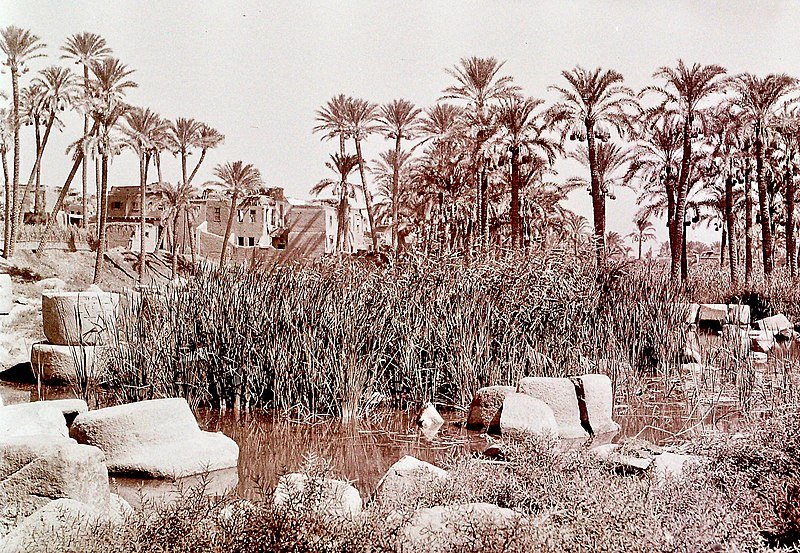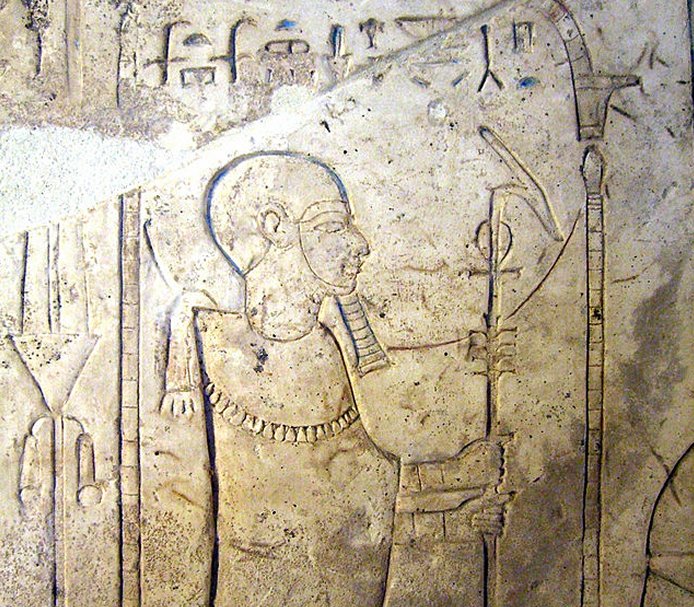God Ptah ‘Lord Of Memphis’ Was Among The Most Revered Creator Gods Of Ancient Egypt
A. Sutherland - AncientPages.com - Ptah was among the most revered creator gods of the Egyptian pantheon, next to Amun and Ra. He was the creator god and keeper of the craftsmen, architects, and sculptors.
Ptah’s origin is widely accepted as unknown; he had no parents as he was the creator of everything from the beginning.
The ruins of the Ptah Temple Memphis, on the background the village of Mit Rahín; as of 1975. Image credit: Zemanst - CC BY-SA 4.0
Ptah was an ancient god worshiped during the Early Dynastic Period and the earliest myths and legends related to him are lost and he is almost omitted in the Pyramid Texts but as the creator of agricultural fertility in Egypt, Ptah is better-known from the Coffin Texts and hymns dated to the Ramesside period (1189 BC to 1077 BC) where he is described as “Ptah, father of the gods, Tatenen, eldest of the originals… who begot himself by himself”.
Ptah was usually depicted as tightly wrapped like a mummy with green skin, symbolizing regeneration, and rebirth. As a human figure, Ptah had a false beard, his shaved head was covered with a blue cap crown and he was holding the Staff of Dominion combining the Ankh (life), the Djed (stability), and the Was Scepter symbolizing power.
Ptah was associated with the sacred bull Apis and as a mortuary god, by being in a triad with Sokar (Seker, Sokaris), the Memphite god of the dead, and with the god Osiris.
Ptah was known to have several epithets such as “Ptah master of justice”, “Ptah lord of truth”, “Ptah master of ceremonies”, “Ptah lord of eternity“ just to name a few. These epithets showed his importance both in ancient Egyptian religion and in society at the time, as well.
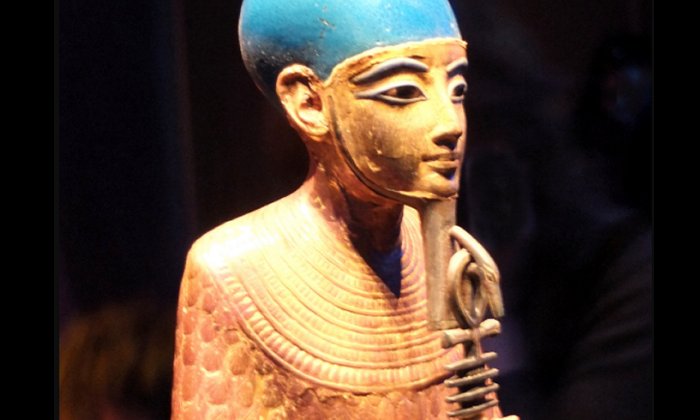 Figurine of the god Ptah, Memphis. Image credit: Siren-Com - CC BY-SA 4.0)
Figurine of the god Ptah, Memphis. Image credit: Siren-Com - CC BY-SA 4.0)
During the New Kingdom, Ptah was a state god and at that time, he was worshiped in many other places, such as Nubia, where his presence was found in several temples including those of Ramesses II at Abu Simbel, el-Derr, and Geri Hussein.
In the triad of Memphis, Ptah was the highest god with Sekhmet and Nefertem. He is the husband of Sekhmet and the father of Nefertum. He was also regarded as the father of the sage Imhotep.
Undoubtedly, Ptah was closely linked with the city of Memphis, which at the time of its founding was known as “Ineb-hedj” (White Walls), and later, around 3000 BC, during the unification of the country, it was called Memphis. During the Middle Kingdom (2040-1782 BC), the great god Ptah was titled “Lord of Ankh-Tawy” and it referred to the city of Memphis.
Interestingly, there are many scholars who say that the name of Egypt itself is based on the Greek form of the Egyptian “Hut-ka-Ptah” which means “the temple of the ‘ka’ of Ptah”.
The god Ptah-Detail of the relief of the high priest Chedsunefertoum-Reign of Chechanq I-XXII Egyptian dynasty - Louvre Museum / Casio EX-S500
In his book "The Complete Gods and Goddesses of Ancient Egypt" Richard H. Wilkinson says that “during the Old Kingdom the high priest of Ptah bore the title “wer-kherep-hemu”, which means “great leader of the craftsmen” and while the god’s name gives no firm clue to his origin it is perhaps based on a root of later words meaning “to sculpt” and thus related to his identity as a craftsman god…”
Ptah was both the sculptor and smith of mankind and creator of the arts and crafts... he was also clearly associated with other groups of craftsmen such as the workers of Deir-el-Medina who constructed the royal tombs in the Valley of the Kings. Naturally enough the Greeks and Romans associated Ptah with their own smith gods Hephaistos and Vulcan…”
There are depictions of Ptah standing on a narrow plinth (a base or platform) like one of the hieroglyphs used to write the word “Maat ‘or ‘truth”. It is also believed that Ptah was depicted as a dwarf (a sacred dwarf Ptah-Partakos), as Herodotus claimed to see statues in this form in the temple of Hephaistos (Ptah) at Memphis.
On the other hand, Herodotus perhaps saw only “votive representations of dwarf workmen rather than the god Ptah himself...”
However, “the god also appears in the form of a dwarf on some of the magical ‘cippi’, which were healing tablets of the Late Period.”
Written by – A. Sutherland AncientPages.com Staff Writer
Copyright © AncientPages.com All rights reserved. This material may not be published, broadcast, rewritten or redistributed in whole or part without the express written permission of AncientPages.com
Expand for referencesTyldesley J. The Penguin Book of Myths and Legends of Ancient Egypt
Dorothy J. Thompson Dorothy J. Memphis Under the Ptolemies
Clayton, M. Egyptian Mythology
More From Ancient Pages
-
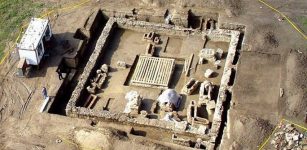 Viminacium Ancient Roman Camp: Sarcophagus With Skeletons, Rich Grave Goods Found In Serbia
Archaeology | Jun 5, 2018
Viminacium Ancient Roman Camp: Sarcophagus With Skeletons, Rich Grave Goods Found In Serbia
Archaeology | Jun 5, 2018 -
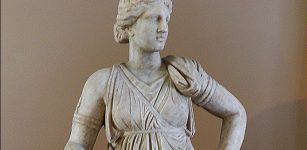 Goddess Artemis – One Of The Most Respected Olympians
Featured Stories | Oct 1, 2016
Goddess Artemis – One Of The Most Respected Olympians
Featured Stories | Oct 1, 2016 -
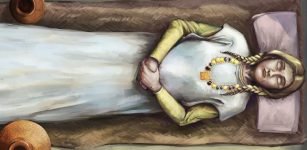 Spectacular Anglo-Saxon Burial Uncovered – Here’s What It Tells Us About Women In Seventh-Century England
Featured Stories | Dec 17, 2022
Spectacular Anglo-Saxon Burial Uncovered – Here’s What It Tells Us About Women In Seventh-Century England
Featured Stories | Dec 17, 2022 -
 Charles VI Of France – The King Who Was Made Of Glass
Featured Stories | Jan 22, 2016
Charles VI Of France – The King Who Was Made Of Glass
Featured Stories | Jan 22, 2016 -
 Underground Orvieto – Etruscan ‘City Under A City’ With Labyrinth, Tunnels, Pyramidal Structures, Oil Mills And Water Supply
Featured Stories | Jul 2, 2022
Underground Orvieto – Etruscan ‘City Under A City’ With Labyrinth, Tunnels, Pyramidal Structures, Oil Mills And Water Supply
Featured Stories | Jul 2, 2022 -
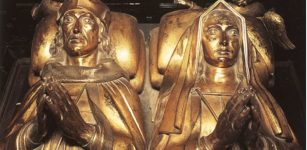 On This Day In History: King Henry VII’s Coronation Was Held – On Oct 30, 1485
News | Oct 30, 2017
On This Day In History: King Henry VII’s Coronation Was Held – On Oct 30, 1485
News | Oct 30, 2017 -
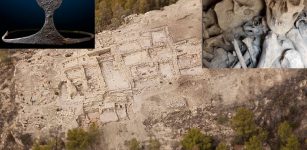 El Argar Civilization: Bronze Age Palace And Grave Goods Unearthed In Spain’s La Almoloya
Archaeology | Oct 15, 2014
El Argar Civilization: Bronze Age Palace And Grave Goods Unearthed In Spain’s La Almoloya
Archaeology | Oct 15, 2014 -
 Mysterious 70-Million-Year-Old Underground Village And Magnificent Tower Of Eben-Ezer In Belgium
Featured Stories | Mar 20, 2017
Mysterious 70-Million-Year-Old Underground Village And Magnificent Tower Of Eben-Ezer In Belgium
Featured Stories | Mar 20, 2017 -
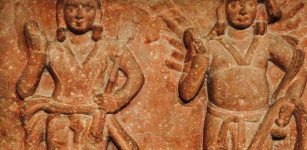 Agni: Hindu God Of Divine Illumination And One Of The Three Supreme Deities Of Vedic Lore
Featured Stories | May 3, 2018
Agni: Hindu God Of Divine Illumination And One Of The Three Supreme Deities Of Vedic Lore
Featured Stories | May 3, 2018 -
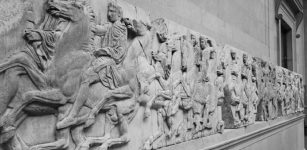 British Museum Is World’s Largest Receiver Of Stolen Goods – Says QC
Archaeology | Nov 12, 2019
British Museum Is World’s Largest Receiver Of Stolen Goods – Says QC
Archaeology | Nov 12, 2019 -
 Paleolithic Cave Dwellers And Light They Could Get In Darkness
Archaeology | Jun 21, 2021
Paleolithic Cave Dwellers And Light They Could Get In Darkness
Archaeology | Jun 21, 2021 -
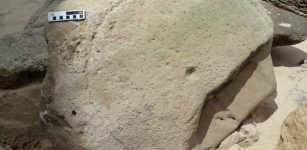 Our Ancestors Made Drawings In The Sand At The Beach 140,000 Years Ago – Scientists Say
Featured Stories | Jul 21, 2023
Our Ancestors Made Drawings In The Sand At The Beach 140,000 Years Ago – Scientists Say
Featured Stories | Jul 21, 2023 -
 Ancient Giants In Ecuador Were Killed By Fire From The Sky – Indian Legends Reveal
Featured Stories | Dec 12, 2017
Ancient Giants In Ecuador Were Killed By Fire From The Sky – Indian Legends Reveal
Featured Stories | Dec 12, 2017 -
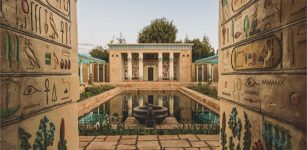 World’s First Recreated Ancient Egyptian Garden Is Now Open To The Public
News | May 17, 2022
World’s First Recreated Ancient Egyptian Garden Is Now Open To The Public
News | May 17, 2022 -
 Cursed Dwarf Fafnir Turned Into A Fearsome Norse Dragon And Guarded The Stolen Magical Ring Andvaranaut
Featured Stories | Aug 16, 2017
Cursed Dwarf Fafnir Turned Into A Fearsome Norse Dragon And Guarded The Stolen Magical Ring Andvaranaut
Featured Stories | Aug 16, 2017 -
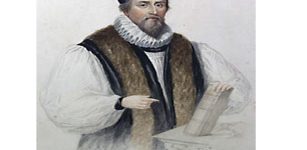 On This Day In History: Bishop of Gloucester John Hooper is Burned At The Stake For Heresy- On Feb 9, 1654
News | Feb 9, 2017
On This Day In History: Bishop of Gloucester John Hooper is Burned At The Stake For Heresy- On Feb 9, 1654
News | Feb 9, 2017 -
 Controversial Unexplained Ancient Mystery In Mongolia – Horrifying Sight – Part 2
Featured Stories | May 2, 2018
Controversial Unexplained Ancient Mystery In Mongolia – Horrifying Sight – Part 2
Featured Stories | May 2, 2018 -
 Scientists In Antarctica Encounter Something Very Strange
Featured Stories | Mar 9, 2020
Scientists In Antarctica Encounter Something Very Strange
Featured Stories | Mar 9, 2020 -
 Discovery At Fujiwarakyu Palace Complex Offers Better Glimpse Of 7th-Century Japan
Archaeology | Oct 21, 2015
Discovery At Fujiwarakyu Palace Complex Offers Better Glimpse Of 7th-Century Japan
Archaeology | Oct 21, 2015 -
 Ancient Mysteries Of Wisconsin – Great Forgotten Prehistoric Events Shed New Light On History Of North America
Featured Stories | Jan 11, 2019
Ancient Mysteries Of Wisconsin – Great Forgotten Prehistoric Events Shed New Light On History Of North America
Featured Stories | Jan 11, 2019

